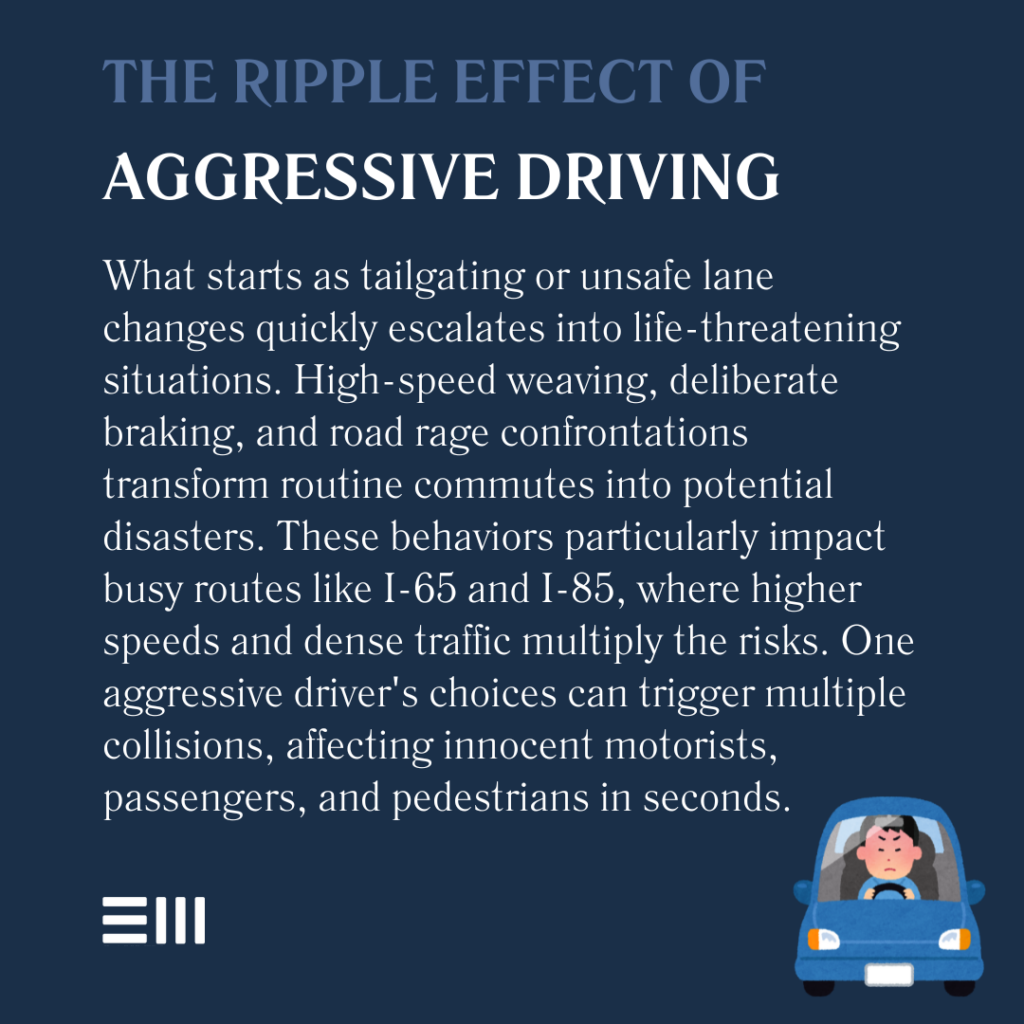
A red light, a sudden horn blast, and the roar of an engine—split seconds that changed lives forever.
On Alabama’s highways, aggressive driving transforms routine commutes into devastating collisions, leaving families to navigate the aftermath of someone else’s road rage.
According to a 2023 study conducted by Forbes Advisor, Alabama is listed among the ten states with the most confrontational drivers.
From tailgating on I-65 to dangerous weaving through Birmingham traffic, these aren’t just accidents—they’re preventable choices with serious consequences.
Understanding Aggressive Driving Behavior
Road rage and aggressive driving manifest in various dangerous behaviors that put all road users at risk. Recognizing these patterns helps prevent accidents and establishes liability when collisions occur.
Road rage and aggressive driving manifest in various dangerous behaviors that put all road users at risk.
The line between assertive driving and aggressive behavior often blurs on Alabama’s busy highways, but certain actions clearly cross into dangerous territory. Recognizing these patterns helps prevent accidents and establishes liability when collisions occur.
Aggressive driving frequently begins with seemingly minor infractions like following too closely or excessive speeding.
However, these behaviors often escalate rapidly into more dangerous conduct. Tailgating at high speeds creates dangerous situations where even minor speed adjustments can trigger multi-vehicle crashes.
Drivers who weave between lanes without signaling disrupt traffic flow and force other motorists to make sudden defensive maneuvers. Running red lights or stop signs, particularly in busy intersections, shows a blatant disregard for safety and often results in devastating T-bone collisions.
More concerning patterns emerge when drivers make unsafe passing maneuvers, especially on two-lane roads where limited visibility increases collision risks. Some aggressive drivers deliberately block others from changing lanes or merging, creating dangerous bottlenecks in heavy traffic.
The use of high beams to harass other drivers, particularly at night, can temporarily blind motorists and lead to loss of control.
Perhaps most dangerous is the practice of deliberate brake checking, where angry drivers suddenly brake to antagonize those behind them, often triggering rear-end collisions or multi-car pileups.
Common aggressive driving behaviors include:
- Tailgating at high speeds;
- Weaving between lanes without signaling;
- Running red lights or stop signs;
- Making unsafe or illegal passing maneuvers;
- Blocking other vehicles from changing lanes;
- Excessive speeding, especially in adverse conditions;
- Using high beams to harass other drivers; and
- Deliberately braking to antagonize following vehicles.
These behaviors often escalate quickly, creating dangerous situations for everyone on the road.

Legal Consequences of Aggressive Driving
Alabama law addresses aggressive driving through various statutes and regulations, with specific attention to high-risk areas like school zones and construction sites. Understanding these legal frameworks helps victims pursue justice and compensation.
Key legal considerations include:
- Criminal charges for reckless driving with potential jail time;
- Enhanced penalties for repeat offenders and serious injuries;
- Civil liability for damages and injuries to multiple parties;
- Impact on insurance coverage and future premiums;
- Documentation requirements for claims and court proceedings;
- Statute of limitations for filing personal injury suits;
- Potential punitive damages in extreme cases;
- Administrative license suspensions and restrictions;
- Mandatory anger management or driver education programs;
- Commercial driver license implications;
- Points system impact on driving privileges;
- Insurance company reporting requirements;
- Criminal record consequences; and
- Interstate enforcement agreements.
The severity of legal consequences often depends on the specific circumstances, prior offenses, and resulting damages. Alabama courts take aggressive driving seriously, particularly when it results in severe injuries or fatalities.
Common Injuries from Aggressive Driving Accidents
Aggressive driving accidents often result in severe injuries due to the high speeds and violent nature of the collisions. Understanding common injury patterns helps victims seek appropriate medical care and document damages.
Typical injuries include:
- Traumatic brain injuries from impact forces;
- Spinal cord injuries and paralysis;
- Multiple fractures and crush injuries;
- Soft tissue damage and whiplash;
- Internal organ damage and bleeding;
- Psychological trauma and PTSD;
- Facial injuries and disfigurement;
- Joint and ligament damage;
- Nerve damage and chronic pain;
- Burns from vehicle fires;
- Loss of limbs or amputation;
- Vision or hearing loss;
- Dental and jaw injuries; and
- Long-term disability conditions.
These injuries often require extensive medical treatment, rehabilitation, and long-term care planning. Early documentation and treatment improve both medical outcomes and legal claims.

Proving Liability in Alabama Aggressive Driving Cases
Building a strong case after an aggressive driving accident requires careful documentation and evidence collection. A systematic approach helps establish clear liability.
Essential evidence includes:
- Police reports and witness statements;
- Dashboard camera footage;
- Traffic camera recordings;
- Cell phone records;
- Vehicle damage photographs;
- Skidmark measurements;
- Medical documentation; and
- Expert witness testimony.
Thorough evidence collection strengthens your position in settlement negotiations or court proceedings.
Frequently Asked Questions About Aggressive Driving Accidents in Alabama
Understanding your rights and options after an aggressive driving accident helps you make informed decisions about your case.
How Can I Identify Aggressive Driving Behavior?
Aggressive driving typically involves multiple dangerous behaviors performed deliberately, often with apparent disregard for others’ safety.
What Should I Do Immediately After an Aggressive Driving Accident?
Ensure your safety, call law enforcement, document the scene, gather witness information, and seek medical attention, even for minor injuries.
Does Insurance Cover Aggressive Driving Accidents?
Most policies cover these accidents, but insurance companies may deny claims if the aggressive driver violated policy terms.
What Compensation Can I Recover?
Victims may receive compensation for medical expenses, lost wages, property damage, pain and suffering, and, in some cases, punitive damages.
How Long Do I Have to File a Claim?
Alabama’s statute of limitations gives you two years from the accident date to file a personal injury lawsuit.
How Does Alabama Law Define Aggressive Driving?
Alabama considers multiple traffic violations combined with intent to harass or endanger as aggressive driving, distinguishing it from simple traffic infractions.
What if the Aggressive Driver Fled the Scene?
Unidentified driver cases may still be covered under your uninsured motorist coverage. Document all available evidence and report the incident immediately.
Can I Sue if the Aggressive Driver Wasn’t Ticketed?
Civil claims don’t require criminal charges or traffic citations. You can pursue compensation based on evidence of negligent or reckless behavior.
Take Action to Protect Your Rights
Don’t let an aggressive driver’s reckless choices derail your life.
Our experienced legal team understands the complexities of aggressive driving cases and can help you navigate the path to compensation.
Contact our office today for a free consultation. We’ll evaluate your case and explain your options for pursuing justice.
Can't find what you're looking for? Search our site below.










